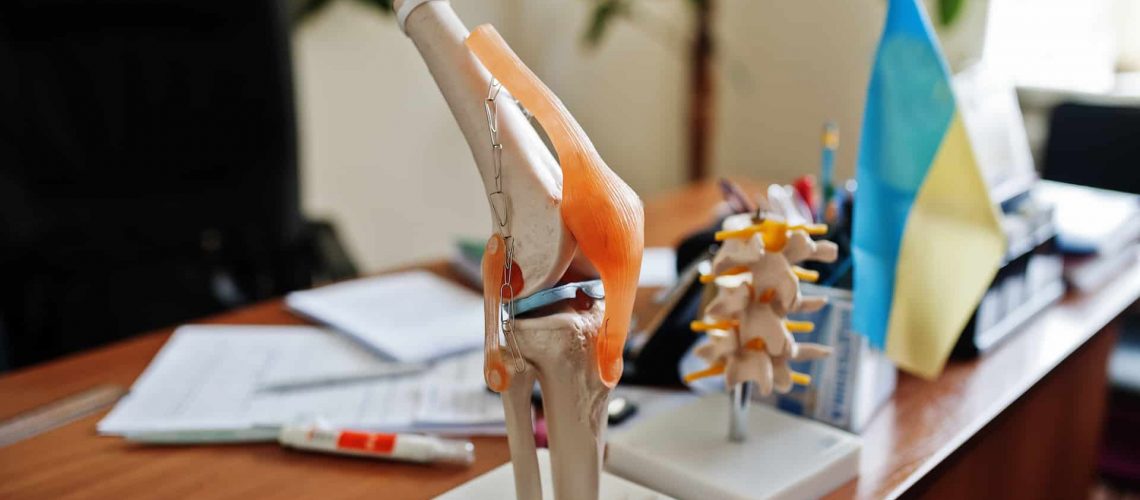Knee replacement surgery is among the top successful surgical interventions in modern medicine. In most cases, revision knee replacements enable people to lead a lifestyle free of chronic pain.
However, over time, a knee replacement may need to be revised as it starts to wear down or fail (a lesser possibility). We’ve been helping people with their knee replacements in Wyoming for decades — let us show you what it is, when it’s needed, and what to expect.
Contents
What is Revision Knee Replacement?
Knee revision surgery is a procedure in which the patient’s damaged or diseased joint surfaces are removed and replaced. This can be done for both knees at the same time, as well as one at a time.
The goal of revision knee replacement is to improve function and relieve pain so that patients can resume their normal activities without limitations caused by arthritis or injury.
When is a Revision Knee Replacement Needed?
You may need revision knee surgery because your pain has not improved after other treatments, such as medication and physical therapy. You might even have tried alternative treatments before revision surgery with no success.
In this case, revision knee replacement can be used to provide relief from chronic arthritis that affects the area around the joint.
Additionally, there are some other scenarios where a knee replacement might be needed:
- When arthritis is the culprit and only one knee needs revision, a total knee replacement may be indicated.
- If pain has progressed due to other injuries (including an ACL tear) and both knees need revision, surgeons will do them simultaneously in what’s called “bilateral” revision surgery.
- Patients who have had their first prosthesis for five years or longer are also candidates for revision because they’ve outlived its expected lifespan.
- Arthritis, trauma, or injury can also cause revision knee surgery to become necessary.
What to Expect with a Revision Knee Replacement
If a revision is necessary and your orthopedist has recommended revision surgery, it can be done as a minimally invasive procedure with anesthesia on the muscles instead of an IV.
The surgeon will make small incisions to get access to the joint space; then they remove any damaged parts of the prosthesis while preserving healthy tissue. Your new replacement may also have more metal components that provide greater stability than what was originally implanted, which could help you avoid future revision needs down the road.
A revision can give people back quality of life once again by giving them relief from chronic pain that they had experienced before total knee replacement surgery was first performed decades ago.
What is the Recovery Period Like for Revision Knee Replacements?
The recovery process will depend on what revision surgery you’re getting, but in general, your doctor can give you a target date for when to expect physical therapy. Recovery periods vary depending on age and medical history, as well as any revision surgery performed.
Typically, it takes six months to return to the level of activity and sports participation that was possible before revision knee replacement. However, athletes may need longer than this due to their high-level training demands.
It’s important not to rush back into activity or sports too soon because doing so could lead to re-injury and additional revision needs down the line.
You’ll also want some help with daily tasks during revision recovery while your muscles are healing — so be sure someone is available at all times should they be needed!
What are the Long-Term Outcomes of Revision Knee Replacements?
The long-term outcomes for revision surgery are positive because it means you’ll be able to live an improved life while avoiding future revision needs down the road!
Athletes who undergo a second total knee replacement will likely see improvements in performance once again if their first prosthesis has worn out over time.
Your new replacement may also have more metal components that provide greater stability than what was originally implanted, and this can help you avoid future revision needs down the road.
It’s important to note, though, revision knee replacements are not a cure-all for chronic arthritis pain — they’re just one potential solution among many others like medication, physical therapy, or even alternative treatments with no success.
Is a Revision Knee Replacement Right For You?
If you’re suffering from knee pain, it’s important to consult with an orthopedic specialist that can help determine what the best course of treatment is.
Treating everything from fractures and traumatic injuries to joint replacement and sports injuries, Thunder Basin Orthopaedics and Sports Medicine gives individualized treatment using a variety of techniques to operate with less damage to the body.
Looking for the skilled staff and top surgeons to get you back on your feet and back in the game? Contact Thunder Basin Orthopaedics and Sports Medicine today. You can also find new patient paperwork here to get a head start on getting back to living life to its fullest and working toward becoming pain free!


